My latest challenge has to been to develop a good vegan pizza – without the use of vegan cheese. Obviously it wasn’t going to be cheesy but I wanted it to have a combination of flavours and textures that satisfied my pizza appetite.
At the same time, I also want to document the cast-iron skillet + grill (US: broiler) technique I use to cook pizza these days.
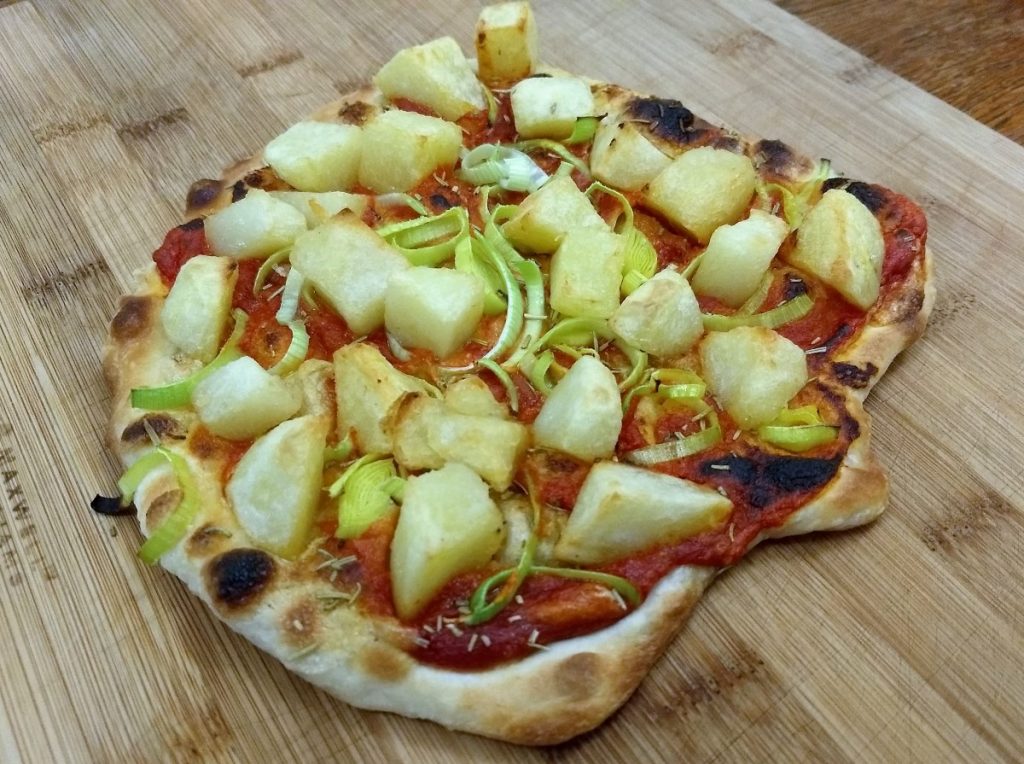
Ingredients
Makes 3 medium pizzas, serves 3-4.
You will need a cast-iron skillet and a grill (US: broiler).
Cashew sauce
- 0.5 cup raw cashews
- 0.25 cup water (approx)
- 1 tbsp olive oil (approx)
- 1 tsp nutritional yeast (optional)
- 0.5 tsp salt
- 0.5 tsp garlic powder (optional)
Pizza base
- 2 teaspoons dried yeast
- 180ml warm water
- 315g strong flour
- 1 teaspoon salt
- 1.5 tbsp olive oil
Pizza
- 3-6 tbsp tomato paste
- 3 tbsp extra light olive oil
- 3 tbsp extra virgin olive oil
- fresh (or dried) rosemary
- 2 cups diced roasted potatoes (about 3 good sized potatoes)
- 1 leek – sliced
Method
The general order of things is:
- Much earlier – make pizza dough and leave to rise
- Earlier – roast potatoes
- Make cashew sauce
- Prep other ingredients
- Make pizza
- Eat pizza
Cashew sauce
- Combine ingredients and blend.
The texture should be spreadable, add more extra virgin olive oil if required.
Pizza base
- Mix yeast into warm water and leave 10 minutes to develop. It should froth up a bit. If it doesnt, either the water is too hot or the yeast is dead, try again.
- Sift flour and salt into a large bowl.
- Make a well, pour in yeast mixture and olive oil.
- Mix to combine.
- Turn out onto a floured surface and knead until it’s all the same consistency and springs back when pressed.
- Apply a fine coat of olive oil, put back in the bowl and cover. Leave in a warm place until it has risen to at least twice the original size.
Pizza
Get everything ready first.
- Take a third of the dough and roll out to the size of your skillet.
- Heat the skillet to medium-hot and the grill to medium.
- Put 1 tbsp of extra-light olive oil into the skillet.
- Put the rolled out dough into the skillet.
- Coat with about 2 tablespoons of the cashew cream and 1-2 tablespoons tomato paste (to taste).
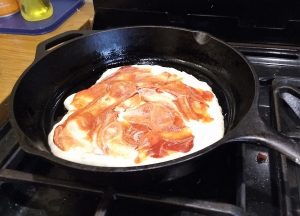
- Sprinkle leeks, roast potatoes, rosemary and salt.
- Drizzle extra virgin olive oil over the top.
- Put the skillet under the grill.

- Leave under the grill until it looks cooked (some slight blackening is expected).
- Return the skillet to the burner and cook until the base is done (it should be nicely browned).
- Remove, slice and serve.
We made this recipe from http://bitofthegoodstuff.com/ today. We’ve been trying different recipes each year and now we’ve found the one! (the recipe below includes our changes -more spice and more sultantas – but you can see the original at http://bitofthegoodstuff.com/2013/03/hot-cross-buns-dairy-free-egg-free-vegan/ )
Hands on time: 30 minutes Resting time: 1¾ hours
Cooking time: 20 minutes
Makes 15 medium or 12 large buns
Ingredients
Dough
– 250ml / 9 oz / 1 cup fortified soya milk (or other non dairy milk)
– 1 tsp fast action / easy bake yeast
– 2 tbsp sugar
– 2 tbsp neutral flavoured vegetable oil, such as rapeseed (canola)
– 500g / 17½ oz / 3½ cups plain (all purpose) flour
– 1 tsp salt
– 6 tsp mixed spice
– 200g / 7 oz / 1 packed cup sultanas or raisins
– 100g / 3½ oz / ½ cup Italian mixed peel
– Finely grated zest of 1 organic/unwaxed orange
-85ml / 3 fl oz / ¼ cup freshly squeezed orange juice (or other fruit juice)
Crosses
– 3 tbsp plain (all purpose) flour
– 2 tbsp water
Glaze
– 2 tbsp sugar
– 2 tbsp freshly squeezed orange juice (or other fruit juice)
Method
Gently heat the milk until it is lukewarm. Remove from the heat and whisk in the yeast and sugar. After a couple of minutes the yeast will start to froth.
In a large bowl, mix together the flour, salt, spices. Stir in the sultanas, citrus peel and orange zest. Make a well in the centre of the dry ingredients and stir in the oil, yeast milk mixture, and orange juice. Bring together the ingredients using your hands. The dough should be soft and sticky. Depending on the type of flour used, you may need to add a little more liquid.
Turn out the dough onto a lightly floured surface and knead for 5 minutes or so, until the dough is smooth. Place the dough in an oiled bowl, cover with a damp tea towel or oiled cling film (plastic wrap) and leave in a warm place for an hour or so until it has doubled in size. If your house is cool (like ours), cover with oiled foil and place in the oven at 40C / 100F for an hour.
When the dough has risen, knead for a further 10 minutes then divide into 12 or 15 equal size balls. To ensure that the buns are exactly the same size and bake evenly, I weigh the dough. My dough tends to weigh about 1.125kg, so I tear off 75g for medium size buns. Roll the dough into smooth balls and evenly space out on a large baking tray (28 x 40cm / 10 x 15”) lined with non stick baking paper. Cover with the damp tea towel, oiled cling film (plastic wrap) or foil and leave in a warm place for 45 minutes or so, until they have risen.
Heat the oven to 210C (190C fan) / 410F.
To make the crosses, mix 3 tbsp plain (all purpose) flour with 2 tbsp water to form a thick paste. Spoon into an icing bag with a thin nozzle (or a plastic freezer bag and snip the corner). Slowly pipe along each row of buns, then repeat in the other direction.
Place in the oven and bake for 20 minutes on the middle shelf, until golden brown.
To make the glaze, gently boil the sugar and fruit juice in a small pan for about 5 minutes until it starts to thicken into a syrup. Brush over the buns while they’re still hot. Allow to set before serving. These buns are most delicious served warm or toasted.
The buns will last 2-3 days in an airtight container. They also freeze well. I tend to slice them in half before I freeze them so that they can be toasted without the need to defrost first.
This calzone was the second course for a dinner we hosted last week. Thomas had a day off work so he did all the cooking!
The calzone was made and assembled before-hand so all we had to do was pop it in the oven, which meant no running in and out of the kitchen and more time to sit and talk with friends (and drink wine!).
The bread was golden and crusty and the filling had a lovely tart taste due to a combination of olives and feta.
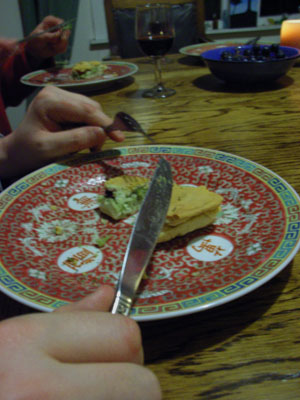
Dough
- 1 1/3 cups warm water
- 1 tsp sugar
- 4 tsps active yeast
- 4 cups ‘strong’ bread flour
- 2 tbsps extra virgin olive oil
- extra flour (for kneading)
- extra olive oil
Prove the yeast by putting the warm water into a small bowl, dissolving the sugar into it and then adding the yeast. Leave in a warm place and the yeast should start bubbling and frothing within 5-10 minutes. If not – you need to start again with better yeast.
Sift the flour into a large bowl, add the olive oil and the yeast/water mixture. Mix to combine into a dough. Remove the dough and knead for five minutes on a flat, floured surface.
Put a dribble of olive oil into the bowl and coat the bottom and sides with it. Put in the kneaded ball of dough and move it around so it too has a fine coating of olive oil. Cover the bowl with a clean towel and leave in a warm place. It should rise to 2-3 times the size in an hour or two.
Optional – knead the dough again and then let it rise again.
Briefly reknead the dough and then divide into two. Roll/spin/press the first half into a flat sheet. Either flour or oil the tray/pizza-stone you’re going to cook it on and put the dough on it. Then it’s time to start adding ingredients.
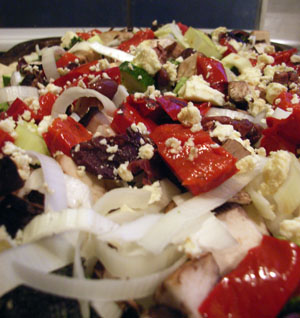
Filling Ingredients (adjust to taste)
- 2 tbsp basil pesto
- 1 head broccoli – chopped into small florets
- 1 leek, chopped
- 2 large portobello mushrooms, chopped
- 100gms feta, crumbled
- 20 kalamata olives, pitted and cut into two
- 150gm roasted capsicum, chopped
- 100gms mozzarella, grated
- 50gms cheddar cheese, grated
Spread the pesto over the base. Add the rest of the ingredients in roughly the order given, finishing off with the mozzarella and cheddar cheeses on top.
Take the rest of the dough and roll/spin/press out into a second flat sheet and use it to cover the other one. It needs to go all the way to the sides so you can seal the calzone by pressing down on the edges.
Topping
- 1 tbsp extra virgin olive oil
- 2 tsp rosemary and/or oregano (fresh is best, dried is ok)
- salt
- pepper
Coat the top with the olive oil. Sprinkle on the rosemary, oregano, salt and pepper.
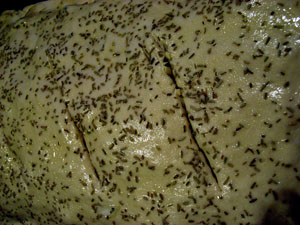
Make three 5-10cm diagonal cuts in the top of the calzone. This lets steam escape while it’s cooking.
Put into a hot oven (220c) until done – approximately 20-30 minutes. Cooking time is fairly imprecise as it’s going to depend on the size and composition of the calzone. Towards the end of the cooking time you may wish to remove the calzone and tip it slightly – any excess liquid should drain out – return to the oven to finish.
Let cool for a few minutes and then cut into long slices (it looks more dramatic that way) and serve. (serves 5)
A quick, simple and yummy snack. It’s especially good when you’re cooking for one or in a hurry.
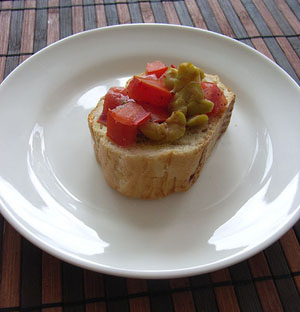
Ciabatta, Tomato and Olives
- Rub bread with garlic.
- Add chopped tomato.
- Add chopped green olives.
- Drizzle with extra virgin olive oil.
- Place in oven until warm.
- Apply salt and pepper.
Enjoy,
Kim
I’ve made this recipe a few times now and it’s always tasted yummy. One thing I do suggest is making the effort to get small grapes. The larger ones seem to turn into lip burning juice bombs.
Oh, and never ever put your piece of hearthbread down on a surface you’ve just used for cutting garlic. Grapes and garlic don’t really go together. Who’d have thought it?
Sweet Grape Hearthbread
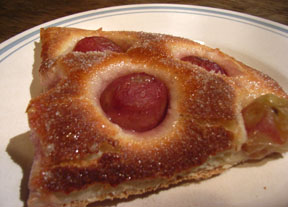
Sponge:
- ½ cup standard flour
- 1 tbsp sugar
- 1 tbsp sure bake yeast
- ½ cup of warm water
Dough:
- 3 to 4 cups of standard flour
- 1 cup warm water
- 2tbsp olive oil
- 3 tbsp sugar
- 1 tsp salt
Topping:
- 2 tbsp olive oil
- 300-400g small grapes
- 2 tbsp sugar
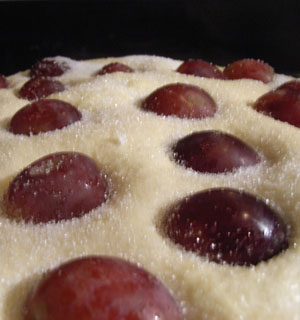
Put all the sponge ingredients in the bowl of an electric mixer and whisk until smooth. Set aside for 10-30 minutes.
To make the dough, add to the bowl the warm water, olive oil, sugar, salt and 3 cups of flour. Mix in with a wooden spoon, adding more flour if needed to make a soft dough. Attach the dough hook to the machine and knead the mixture for about 5 minutes. Detach the dough hook and cover the bowl with a damp tea towel.
Set aside in a warm place until the dough has risen by at least double.
Tip the dough onto a lightly floured bench and roll out approximately 3mm thick to fit into a shallow-sided baking dish approx 45x30cm. Brush the dough lightly with olive oil and set aside until it is well-risen and puffy. Depending on room temperature, this will take an hour or so.
Half an hour before the dough is likely to be ready, turn on the oven to 220°C. When the dough has risen, use your fingers to press deep dimples into it. Scatter the grapes over the dough, so that many of them are lodged in the dimples. Use the flat of your hand to press the grapes firmly into the dough. Sprinkle generously with sugar and bake in the preheated oven for 15-20 minutes until the dough is golden brown and the fruit bursting.
Slide the hearthbread onto a rack, and leave to cool until lukewarm before cutting into 12 large squares. Serves 6.
note:
The recipe says to use a mixer but I did it all by hand and it was fine.








